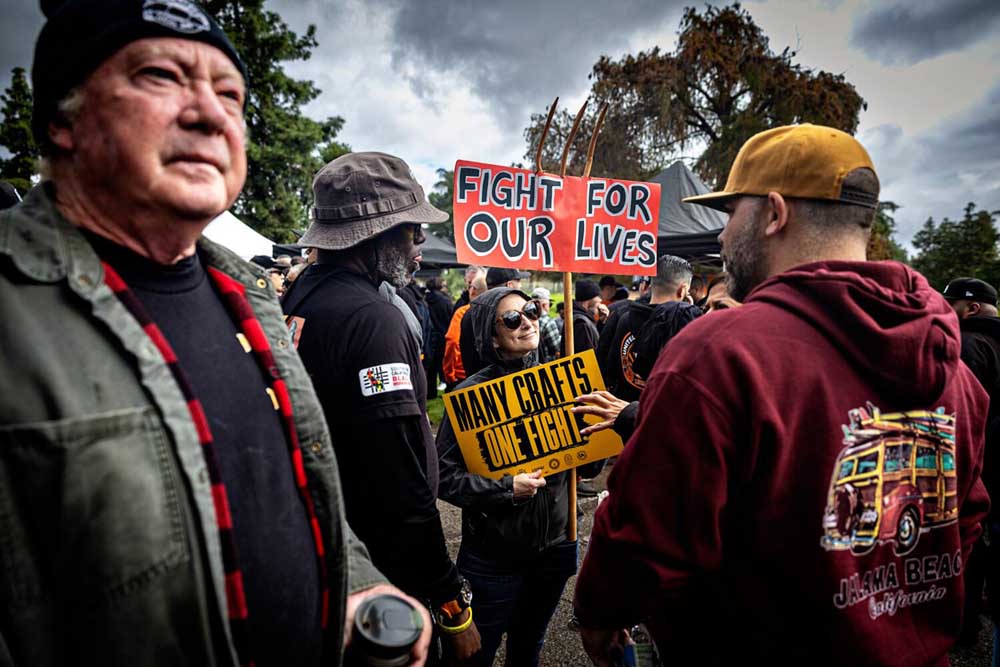Hollywood’s crew union negotiations have gone well so far. Now the hard part begins
Published 1:33 pm Monday, April 29, 2024

- Hollywood crew members union IATSE rally at Woodley Park to kick off their contract negotiations with the major studios in Encino, California.
In a departure from the labor rebellions that roiled Hollywood last year, the latest set of contract negotiations between a major entertainment union and the top studios has unfolded about as smoothly as could be expected. So far.
The various West Coast studio locals that make up the International Alliance of Theatrical Stage Employees, which advocates for film and TV crew members, have engaged during the past month in separate bargaining sessions with the Alliance of Motion Picture and Television Producers, which represents Disney, Netflix, Warner Bros and other entertainment companies.
Those talks — tailored to the specific concerns of costume designers, hair and makeup artists, set decorators and other workers — transpired without incident.
Now the union representing so-called below-the-line workers is poised to enter broader negotiations for its basic agreement, which will cover the most pressing items affecting entertainment craftspeople. This phase is the big one that could, depending on how talks go, result in another historic agreement or yet another work stoppage.
“The stakes are very high … certainly in light of what happened last year,” said Todd Holmes, associate professor of cinema and television arts at Cal State Northridge. “It’s a challenging environment. There’s need for cautious optimism because of what’s gone on individually with the crafts, but I still think it’s going to take some time to iron out an agreement.”
Unlike the Screen Actors Guild-American Federation of Television and Radio Artists and the Writers Guild of America, IATSE has never staged a nationwide strike in its 131-year history. It came close, however, in 2021 when crew members overwhelmingly voted in favor of authorizing a walkout. (IATSE and the AMPTP ultimately averted a work stoppage by settling their standoff shortly before the strike was set to commence.)
This year, a crew member walkout is looking decreasingly likely. However, some have speculated that the slow return to production in the wake of the writers’ and actors’ labor actions could be due in part to the companies playing it extra safe in anticipation of another potential shutdown.
The overlapping writers’ and actors’ walkouts came as a devastating blow on both sides of the bargaining table, rendering countless crew members jobless for at least six months and upending the release schedules of the entertainment companies, which were already struggling financially due to overspending from the streaming wars.
“Look, people need to work,” said Matthew Loeb, IATSE’s international president. “And to the extent that our goals are met, the earlier [a deal is struck] the better. … We don’t want companies holding off on greenlighting pictures or moving them. We want to keep the business on track and make the recovery from last year.”
In a statement provided to The Times, a spokesperson for the studios said, “The AMPTP is pleased by the progress we have made and remains focused on the task at hand: collaborating with our union partners to reach a fair deal that keeps crew members on the job without interruption and recognizes the contributions they make to our industry.”
Prior to the start of general negotiations, the 13 Hollywood locals struck tentative deals with the AMPTP according to each group’s needs.
The trade-specific agreements fell like dominoes, beginning March 22 with the cinematographers (Local 600), art directors (Local 800) and set painters (Local 729) and ending last week with the studio teachers (Local 884) and affiliated property craftspeople (Local 44). The union has remained tight-lipped about the contents of those deals, though craft-specific contracts historically have addressed issues such as workflow for editors, camera operating practices and working conditions for costumers.
Loeb hopes that’s a good omen for the tenor of the ongoing negotiations.
“It’s civil,” Loeb said. “I think their demeanor is right. Everybody wants to avoid a strike. But that’s not to say that it’s a foregone conclusion that they’ll meet our demands.
“It’s not a war,” he added. “We don’t bargain for a strike. We bargain for a contract.”








